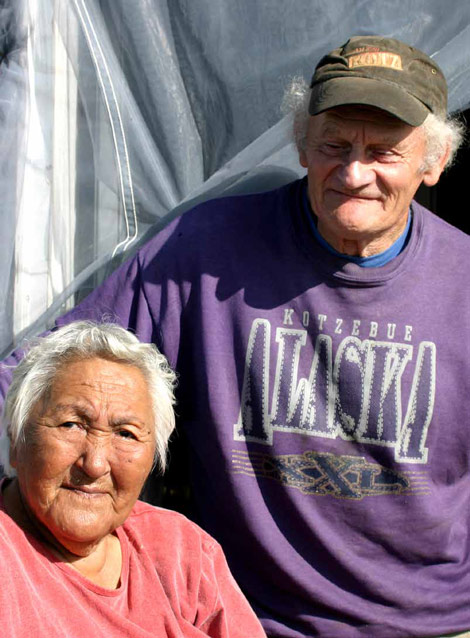
Greg Gusse
Bob Uhl and his late wife, Carrie (Figure 1), lived in remote sites in Cape Krusenstern National Monument for more than 50 years (Figure 2). Bob first arrived in Kotzebue in 1948 while serving in the Army, and stayed in the area. Carrie grew up in a traditional Iñupiaq family in Kotzebue Sound. For many years, the couple lived at Sisualik in the summer and moved inland to a cabin amid the trees at Sanningaruq during the winter.
From 1990 to 2004 Bob kept journals of daily observations; these unique accounts provide a wealth of information about weather, climate, flora, and fauna.
Birds appear in almost every day’s entry. As a subsistence user, Bob related to the birds as a source of food. As a fellow dweller of the natural world, he also saw them as friends. Above all, however, Bob was a naturalist who knew changes in certain populations affected other parts of the ecosystem. His journal records the birds’ seasonal migrations, deviations from expected behavior, and connections between birds and other species.
Birds as Food Sources
In a 1977 report about subsistence patterns of residents of the Cape Krusenstern area, Bob and Carrie Uhl asserted that birds and eggs were among the most essential local foods. They pointed out that migratory birds arrived in the spring after seven months of a practically birdless sky. Not surprisingly, although bird hunting was then only allowed in the fall, “this regulation goes against practical subsistence living and is widely disregarded” (Uhl and
Uhl 1977). A 1997 bird harvest survey conducted by the Alaska Department of Fish and Game (ADFG) in Kotzebue shows that this pattern continued: while 27.6 percent of the households that regularly hunted birds harvested ducks in spring, only 17.6 percent took ducks in the fall (ADFG 1997). Fortunately, a spring subsistence hunting season for migratory birds went into effect in 2003, recognizing the long tradition of spring bird hunting in rural Alaska.
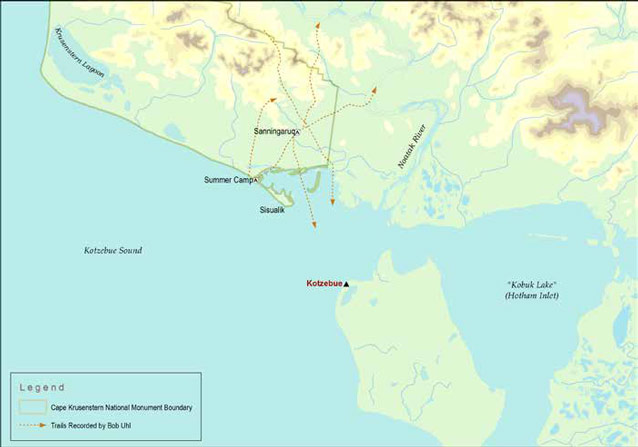
The northern pintail (Anas acuta, Iñupiaq kurugaa), one of the first ducks to arrive in May, was probably the most important subsistence bird species in the Cape Krustenstern area. "He usually has a thin layer of fat left from his long flight and makes a delicious pot of soup that you can almost feel course through your winter-tired body." Elderly Iñupiat were particularly fond of it (Uhl and Uhl, 1977).
Eggs of all kinds were gathered in the spring. Glaucous gulls (Larus hyperboreus, Iñupiaq nauyasugruk) produced the largest number of eggs used for subsistence, although Arctic tern (Sterna paradisaea, Iñupiaq mitqutailaq) eggs were considered the most delicious (Uhl and Uhl, 1977). In 1997, 23.7% of Kotzebue bird-hunting households harvested gull eggs, showing the continued popularity of this resource (ADFG 1997).
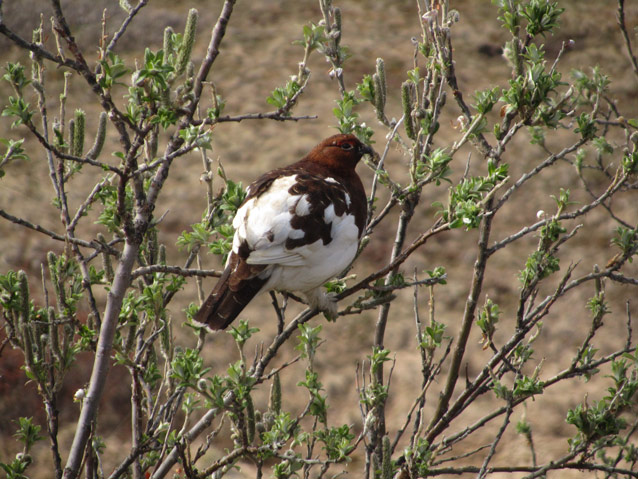
NPS Photo
Willow ptarmigan (Lagopus lagopus, Iñupiaq agargiq) live year-round in the area (Figure 3). The Uhls said everyone liked this bird: “It eats willow buds, berries, and a few insects, and has a delicious energy-giving meat.” (Uhl and Uhl 1977). According to anthropologist Ernest S. Burch, Jr., in the late 19th century, people stayed alive in late winter by catching ptarmigan with snares. Young boys learned to hunt by shooting ptarmigan with bows and arrows (Burch 2006). Uhl’s journals are full of references to willow ptarmigan. As one of the few birds that wintered over in the area, it was reliably one of the species recorded in the Audubon Christmas Bird Count conducted at the Uhl’s cabin in Sanningaruq.
The numbers of ptarmigan varied greatly over the years. When it was available, Bob and Carrie ate willow ptarmigan throughout the winter. Frequently they received ptarmigan as a gift from a young hunter, suggesting the bird’s continuing role as a training species. In 1997, 37.4 percent of bird-hunting Kotzebue households harvested ptarmigan (ADFG 1997).
The Uhls trapped snowy owls (Bubo scandiacus, Iñupiaq ukpik) when they arrived for a short season (Figure 4). Like some older Iñupiat, they liked the flavor of snowy owl soup. Owl traps were constructed of driftwood posts with an attached chain that caught the bird’s leg (Uhl and Uhl 1977). In October 1992, Bob wrote, “Set four Snowy Owl traps today. Haven’t seen our two summer owls for some time. Hope they have gone far away” (Uhl 1990-2004). He evidently hoped their resident owls wouldn’t end up in the soup pot. No Kotzebue households reported taking any owls in 1997 (ADFG 1997).
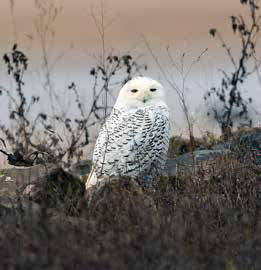
Photo courtesy of Jim Dau
Birds as Friends
Some of the most frequent “characters” appearing in Bob’s journals are birds. He and Carrie recognized many birds that stayed around their camp for days or weeks, including some who returned year after year. They assigned names to a few: Jonathan Livingston Seagull, a glaucous gull; Lucinda, his mate; Peg, a glaucous gull with a lame leg; Pipsqueak, a mew gull; Sweetie Pie the chickadee. Others, like the tree swallows, the snowy owl, and the hawk owl, did not acquire names but were nevertheless treated as friends.
Occasionally Bob reflected on human-caused or natural tragedies in the birds’ lives. He once found a dead boreal chickadee that had flown into the cabin window. “Such a sad ending for a friendly little creature that has come by for a visit every day for six months,” he wrote (Uhl 1990-2004). When he saw a glaucous gull with a broken wing seeking food in the slushy edge of the frozen lagoon, Bob commented, “The Death Angel that will relieve his condition and situation will likely be one of the numerous Sisualik foxes that patrol the beach and marshes for that very purpose” (Uhl 1990-2004).
The tree swallows (Iridoproene bicolor, Iñupiaq tuluġaġnauraq) came back to the Uhls’ summer camp every spring, and raised their young in a box Bob made for them (Figure 5). In July, after they fledged their hatchlings, the parents proudly lined up their family to show off before they all flew away. Not all the youngsters survived. One year, after the birds departed, Bob found the remains of two hatched birds that had apparently succumbed to unusual freezing temperatures earlier that year (Uhl 1990-2004).
The Uhls’ glaucous gull friend Jonathan habitually perched atop the swallow box and surveyed the landscape (Figure 6). The tree swallows and Jonathan maintained an uneasy co-existence. Bob praised the bravery of the mother tree swallow who sat on her nest with a huge gull sitting above her.
Jonathan, who first appeared in the journals in
1991, was the most loyal of avian friends. He must have been growing elderly, as were the Uhls, when they last saw him in 2004. Every year, they anxiously awaited Jonathan’s arrival around April 30, and were always eventually rewarded when he returned, initially shy.
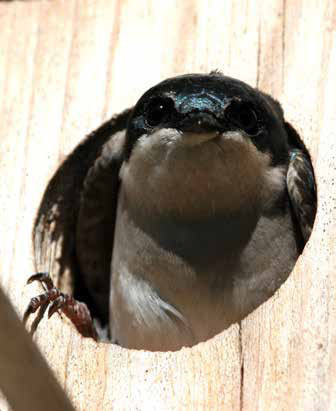
Donna Dewhurst
Jonathan became tamer after the first few days in camp each year, following Bob around in hopes of fish scraps. He would not eat food from Bob’s hand, but his mate Lucinda did. Once she impressed Bob greatly by using him for protection from other gulls in order to get food to her offspring.
Lucinda took some food from Bob, then regurgitated it for her young to eat right at his feet, where the other gulls would not dare to approach (Uhl 1990-2004). Each year, Jonathan and Lucinda started to tend a nest of eggs soon after arrival. The Uhls always ate the gulls’ first clutch of eggs, but left the second group for them to hatch. In 1994, the gulls’ nest on an island in the lagoon was flooded and the nearly hatched eggs swept away (Uhl 1990-2004).
Every fall, Bob and Carrie worried because Jonathan and some of his family stayed in camp after other gulls had left, hoping for handouts that would end abruptly when the Uhls moved to their winter home. One October, after even Jonathan was gone, Bob wrote of the five remaining young glaucous gulls, “Most of these are probably not going to survive.
They have focused on the camp as a food source and that
is going to fail. We don’t know how to remedy the situation since it involves their basic instincts” (Uhl 1990-2004).
The Christmas Bird Count
The Audubon Society sponsors an annual Christmas Bird Count (CBC) in locations throughout North America. Bob hosted the Sanningaruq count for many years. Most years, despite the brutal cold, possible blizzards, and lack of daylight, he could rely on helpers who traveled 18 miles from Kotzebue by snowmachine to take part.
After the 1997 count, Bob reflected: “We had a
fine crew of ten brave people who found 554 birds of
ten species in an apparently bird-less landscape” (Uhl
1990-2004). The “best birds” were the gyrfalcon and northern goshawk, whose presence suggested that avian predators were returning to the area. The same count yielded 421 willow ptarmigan, revealing an abundance
of this winter subsistence staple (Uhl 1990-2004).
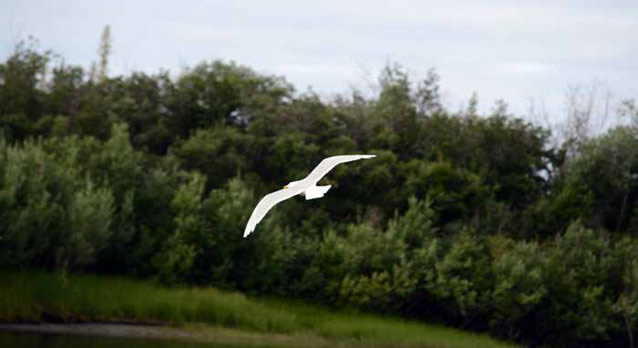
NPS Photo
The primary draw for the CBC, according to ADF&G biologist Jim Dau, was Bob and Carrie’s warm hospitality. After the count, the participants sat down to moose roast, smoked salmon, and a variety of traditional Iñupiaq foods. Over the meal, they discussed happenings and changes in the world of nature and resource management. Jim, his wife Randy Meyers, and one or both of their sons participated
in the Sanningaruq count every year (Dau email 2015).
In 1994, the weather was so bad that Bob and Carrie
did the CBC by themselves. Thanks to a flock of 20
white-winged crossbills, they sighted 34 birds of four
species (Uhl 1990-2004). The 2003 count was cancelled
due to extreme weather; in February, however, an intrepid crew of five came from Kotzebue to do a belated count
for Bob’s journal record. They counted 44 birds of six species, but no birds of prey and few ptarmigan (Uhl
1990-2004). The Sanningaruq CBC became inactive when Bob and Carrie moved to Kotzebue later in 2004.
Bob said he did the CBC because he enjoyed learning about birds from people who knew more about them than he did (Hess 2010). Birders, however, had a different kind of knowledge than Bob’s. The goal of the CBC was to record as many birds as possible—not to eat the birds, or befriend them. Bob always hoped for unusual birds to appear in the CBC; he was excited in 1990 when two three-toed woodpeckers were first counted in the Sanningaruq event (Uhl 1990). One year a northern hawk owl not seen for several years- hung around camp in December but did not show up on count day (Uhl 1990-2004). It came back on New Year’s Day. Bob hoped the return of the northern hawk owl meant that its snowshoe hare prey base was returning. He speculated
that the good spruce cone crop was attracting passerines, which were in turn feeding birds of prey (Uhl 1990-2004).
Patterns and changes over the years in CBC observations are valuable for assessing trends in populations of subsistence resources. For example, the Sanningaruq counts revealed dramatic fluctuations in counts of willow ptarmigan. A record 1,023 willow ptarmigan were sighted in the 1988 bird count (during whiteout conditions), and 421 in the 1997 count, but between those years were low counts of only 10
(1992), 17 (1993), and 0 (1994) (CBC Results 1978-2014).
Bob Uhl as Naturalist
Bob’s perspective on birds came from living with them every day of the year. He noticed patterns over time that showed how parts of the ecosystem were related. In April 1990 he wrote:
This was a very silent winter for birds in the Monument. A poor white spruce cone crop combined with the continued presence of a few Northern Hawk Owls kept woodland species (White-winged Crossbills, Pine Grosbeaks, Redpolls, Gray Jays, Boreal Chickadees) at a bare minimum. Heavy wet snow during the winter depressed seed heads of ocean beach vegetation (Elymus, Angelica, Artemisia) resulting in a scarcity of Snow Buntings and Redpolls also. Ptarmigan were present in moderate numbers and their predators were occasionally observed (Gyrfalcon, Goshawk, Snowy Owl). Bird noise was pretty much restricted to Raven croak, Ptarmigan cackle and Gray Jay scold (Uhl 1990-2004).
References
Alaska Department of Fish and Game, Division of Subsistence. 1997. Community Subsistence Information System. Bird harvest data for Kotzebue Maniilaq Association study.
Burch, Ernest S., Jr. 2006. Social Life in Northwest Alaska: The Structure of Iñupiaq Eskimo Nations. Fairbanks: University of Alaska Press.
Christmas Bird Count Results [AKSA1978-2014], Bob Uhl’s Camp. April 21, 2015. http://netapp.audubon.org/CBCObservation/Historical/ResultsByCount.aspx#
Dau, James. 2015. Email communication to Rachel Mason, April 28, 2015.
Hess, Paul. 2010. Birding in the Twilight Zone. American Birds 2009-2010, Summary of the 110th Christmas Bird Count. Audubon Arkansas. http://ar.audubon.org/sites/default/files/documents/ab_110_twilightzone.pdf
Uhl, W.R., and C.K. Uhl. 1977. Tagiumsinaaqmiit: Ocean Beach Dwellers of the Cape Krusenstern Area: Subsistence Patterns. Anthropology and Historic Preservation, Cooperative Park Studies Unit. Fairbanks, AK.
Uhl, William R. 1990-2004. Daily observations from Sisualik, Cape Krusenstern National Monument, Northwest Alaska. Journals, Vols. 1-14. https://www.nps.gov/cakr/learn/nature/bob-uhl-journals.htm
Part of a series of articles titled Alaska Park Science - Volume 14 Issue 2: Birds of Alaska's National Parks.
Previous: Birds of the Arctic
Next: Birding is for Everyone!
Last updated: May 5, 2016
